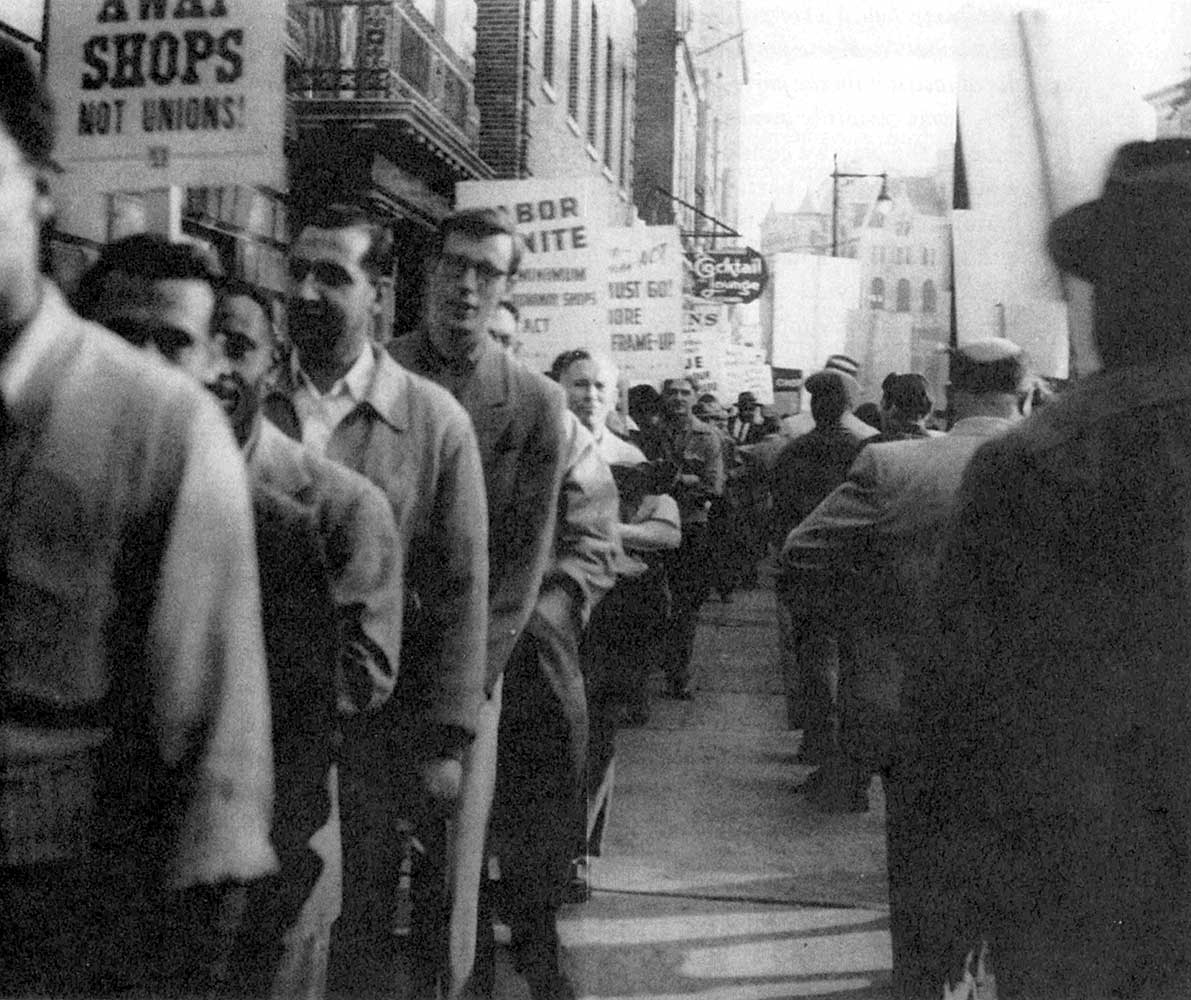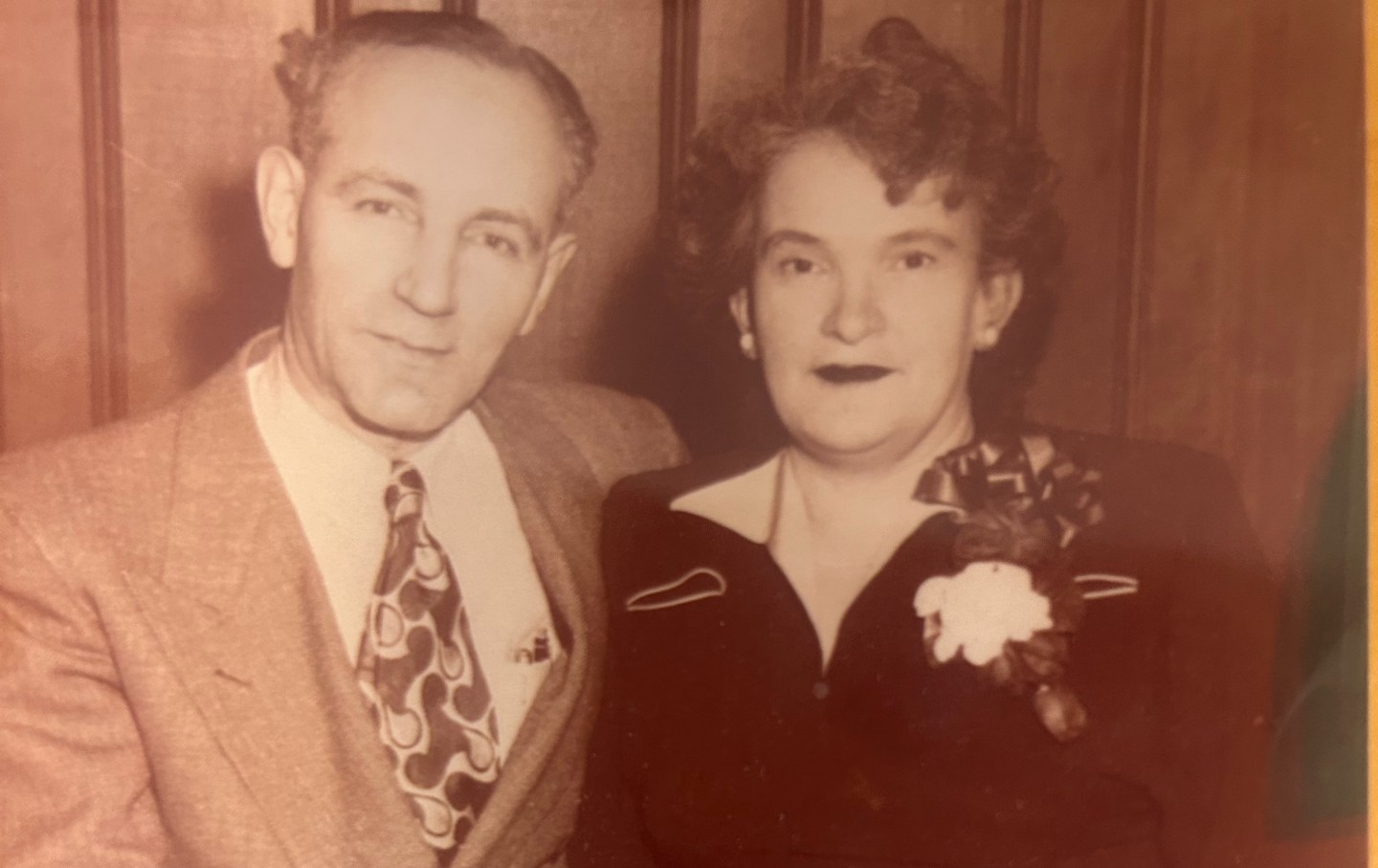The People in the Shop
David Montgomery and the vitality of labor history.
David Montgomery and the Vitality of Labor History
From his first book to his landmark account of the politics of the pre-WWI labor movement, Montgomery explored how people’s experiences of work shaped their political horizons.

One of the paradoxes of contemporary American politics is that the working class may be invisible as a true political force, but the idea of the working class is everywhere. From Teamster leader Sean O’Brien’s appearance at the Republican National Convention to UAW head Shawn Fain’s “Trump Is a Scab” T-shirt, from Kamala Harris and Joe Biden campaigning together at a Labor Day rally in Pittsburgh to the convoluted attempts of JD Vance to articulate a politics for the GOP that rejects neoliberalism and embraces workers, the image of the working class—virtuous, long-suffering, neglected, abandoned—hovered like a specter over the presidential campaign. But for all the invocations of workers, work itself is largely absent. Politicians deploy plenty of cultural signifiers of working-class life: motorcycles, classic rock, red meat. They invoke working-class problems: income inequality, inadequate compensation, medical debt. But few of our contemporary political (or even union) leaders have much to say about the actual experience of work—its tedium, skill, pleasure, camaraderie, exhaustion, power, and freedom.
Books in review
A David Montgomery Reader: Essays on Capitalism and Worker Resistance
Buy this bookThis omission was a problem that the great labor historian David Montgomery set out to tackle. Throughout Montgomery’s long academic career, he was always concerned with the interplay between politics and the workplace. From his first book, a study of working-class politics in the era of Reconstruction (Beyond Equality), to his landmark account of the politics of the pre–World War I labor movement (The Fall of the House of Labor), Montgomery explored how people’s experiences of work shaped their political horizons. Having spent many earlier years in an industrial job, he brought this sensibility to his own workplace, too—making himself available, time and again, to the many different kinds of workers who populate academia: the maintenance and clerical staff, the graduate student instructors and graders, and, of course, his fellow faculty.
An extraordinary new collection of Montgomery’s essays—some previously published, others available here for the first time—offers a chance to see anew the range of his thinking. Edited by James Barrett and Shelton Stromquist (two students of Montgomery’s who are now esteemed labor scholars themselves), A David Montgomery Reader: Essays on Capitalism and Worker Resistance serves as a testament to his commitment to use labor history as a means of grappling with the largest questions in American history. In essay after essay, we can see Montgomery’s desire to look as closely as possible at the material reality of working-class life, while also understanding it within the broad sweep of capitalist development. By placing his work in dialogue with new scholarship on race and transnationalism, the book reveals Montgomery’s lasting impact today, offering us a portrait of the depth, complexity, and vitality of labor history as a field and the political visions that it continues to inspire.
David Montgomery’s own life story revealed a complex relationship to work. History, for him, was a second career. Long before he became a professor, he was a political organizer and a factory worker, and this experience had an indelible impact on his scholarly vision.
Born in 1927, Montgomery grew up in a middle-class family in the Philadelphia suburbs and became interested in politics (mostly Socialist Party politics) while in high school in the early 1940s. He enrolled at Swarthmore College, but his undergraduate education was interrupted by military service at the end of World War II, when America’s attention shifted to the Soviet Union. Drafted in 1946, Montgomery served in Los Alamos, where he was assigned to the radio station at the Army base. There, he witnessed the growing fears of the scientists working at Los Alamos, who worried about the atomic weaponry they were developing, especially after Louis Slotin, a 35-year-old nuclear physicist, died from radiation poisoning following a lab accident. Horrified and in some cases even radicalized by what they had created, the scientists at Los Alamos represented to Montgomery an example of a much older tradition of artisan radicalism: the craftsman who becomes unable to ignore the politics of his trade.
After his military service ended, Montgomery returned to Swarthmore—but, like so many of his generation, he came back entirely transformed by the experience: Once on campus, he joined a group of politically engaged veterans and worked with the left-leaning American Veterans Committee. “A sense of rebuilding everything from the bottom up was very strong in a lot of World War II vets,” he recalled in an interview with James Barrett. “It politicized them and made them very serious about their studies. They weren’t just interested in a career.”
After graduating from Swarthmore, Montgomery chose not to follow his peers into desk jobs and the “affluent society” of postwar America. He won a prestigious fellowship that allowed him to travel to Europe and briefly studied sociology and political science at Columbia. But he then left graduate school and went to work for a small electronics manufacturer in New York City, becoming a machinist and then organizing for the United Electrical Workers, one of the leading left-wing unions in the United States at the time. (The UE would ultimately be expelled from the CIO when its leaders refused to testify that they were not members of the Communist Party.)
Montgomery said later that he loved being a machinist because of the craft discipline, the spirit of solidarity, and the intense awareness that “an injury to one is an injury to all.” In the early 1950s, after a short stint working on the manufacturing floor and with the UE, he joined the Communist Party, drawn, as he would later explain, by both the precision of its class analysis and its activism supporting racial equality. This was a bold decision at the time. The early 1950s, after all, were the very height of McCarthyism and a moment when many were leaving the party, though Montgomery’s time as a member would also be brief. He quit the CP in 1957, after Khrushchev’s revelations about Stalin and the Soviet Union’s invasion of Hungary, though he also left for another reason: He felt stultified by the party’s political culture and thought it no longer had much to do with American workers. Yet even in his later years, he would insist that despite his misgivings, the party had inculcated in him a realism and organizing vision “much less doctrinaire in dealing with workers” than the intransigent moralism of the New Left. The Communists, Montgomery explained, “took it for granted that they lived among people of all sorts that all had to be dealt with.” Unlike many in the 1960s who avowed a politics of moral commitment and a critique of consumer society while disdaining the white working class as hopelessly reactionary, the Communists were not picky about whom to organize. For them, the goal was a truly mass politics: The people in the shop could not be wished away, for they were the ones who had to be confronted, engaged, and, if possible, won over.
Montgomery’s political work would bring him both love and exclusion. In 1952, he married the African American activist Martel Wilcher; they had two children and moved to St. Paul. Yet his activism also meant the employers there blacklisted Montgomery from machinist jobs, and he was surveilled by the local FBI office. Frustrated and in need of a steady income, he gave up work as a machinist altogether and returned to graduate school to study history.
Montgomery had actually published one work of history before grad school—an essay, included in the new collection, about the Great Northern Railway Strike of 1894 led by Eugene Debs. It was written on the 100th anniversary of Minnesota’s statehood and published (under the pseudonym Amos Flaherty) in a “people’s history” collection edited by the Communist writer Meridel Le Sueur. At the University of Minnesota, Montgomery sped through his PhD, completing it in two years, with a dissertation on the relationship between the Radical Republicans and the union movement during the Reconstruction era (which eventually became Beyond Equality). He then got a job at the University of Pittsburgh, where he would spend the next 16 years, save for an interlude in England with the British labor historian E.P. Thompson. Then, in 1979, Montgomery went to Yale, where he would teach for the rest of his career. Over the next three decades, he published four books and trained several generations of stellar labor historians.
Despite Montgomery’s success as a scholar, he later insisted that he had turned to a life in academia only after his career as a machinist fell apart: “Becoming a historian was not my first choice. I had to do something, so I took the second-best choice that was around then.” The traditions that he had developed before his time as a professor remained with him. His interest in craft practice and its relationship to political ideas, his sense of the importance of a “militant minority” in any organizing campaign, and his underlying commitment to the idea of workers as deeply intelligent and creative—all of this informed his work as a historian and a teacher. As he said in one interview, “The study of history is a collective and cooperative endeavor, not a competition for personal academic eminence.”
When Montgomery became a labor historian, the field was still dominated by the institutionalism of an earlier generation, which viewed workers as pragmatic utilitarians who joined unions primarily out of narrow economic self-interest rather than a larger politics, and which saw the rise of modern trade unions as the key to understanding working-class history. There were also many historians at the time who believed that organized labor had reached the “end of history” with the advent of the New Deal. According to this analysis, the rise of the CIO and its entrenchment in postwar life was a seismic shift that had led to a sharp reduction in class conflict.
Montgomery had a different perspective. Unlike the older labor historians who had focused on the institutions of organized labor, his interest in unions was secondary to his interest in the political culture of workers. And rather than see American labor history as cresting with the victories of the 1930s, with the postwar order as a desideratum, he saw the rise of the CIO as occurring against the backdrop of the defeat of an earlier labor politics—the “fall” of a late-19th and early-20th-century tradition that, far from being reactionary, held within itself a deep radicalism, especially because of its focus on work and the shop floor rather than consumption.
Influenced by Thompson and a new generation of radical British historians, Montgomery’s early essays in this collection—studies of the “social attitudes” of American workers and artisans in the first half of the 19th century—reflect this interest in workshop culture. He was especially concerned with how the experience of industrialization helped form a politics that was filtered, in turn, through new religious and cultural expressions. In one 1972 study of a series of nativist riots in Kensington, an industrial suburb of Philadelphia, Montgomery made the case that because the “ideology of modernization” involved a “new sense of social order and discipline,” it necessarily focused on the public schools and on temperance—and thus appeared to be a religious and ethnic conflict rather than one driven by class. In another article, first published in Labor History in 1968, he explored the “working classes of the pre-industrial” city, surveying a world of seamstresses, journeymen, mechanics, day laborers, and the “seaport poor.” He called for historians to delve into the “cultural and intellectual life” of these diverse groups so that they might better understand how labor’s “pre-industrial behavior and attitudes” shaped its response to the “spreading factory system.”
The cultural and religious discontents of industrialization, however, were only part of Montgomery’s focus in this period. While he looked outward to culture, as Thompson did, he also looked to the inner workings of the shop floor. During the late 19th century, he explained, employers had sought to dispossess factory “veterans” of their “collective, deliberate, and aggressive” control over the production process. Meanwhile, advocates of scientific management sought to morally delegitimate working-class power in the workplace—making clear that this was a political project rather than one of economic efficiency alone. The radicalism of the early 20th century reflected this immediate past: Many workers who expressed radical sentiments “could remember the recent day when in fact, the manager’s brains had been under the workmen’s cap.”
In one unpublished essay from the late 1960s, Montgomery made this argument by tracing the origins of the syndicalist theory of the Industrial Workers of the World to the everyday practices of American craftsmen. The idea of “the trade union as both a revolutionary force and the basic unit of the socialist commonwealth to come [was] nothing new to the American worker in 1905,” he wrote. Despite the enmity between the IWW and the American Federation of Labor, the ideas advanced by the former had long been embodied in practice by the latter—by the “iron molder, the glass blower, the cooper, the cigar maker, the garment cutter, the brick layer, the carpenter, the locomotive engineer and conductor, the pipe fitter, the blacksmith, the printer, the tailor, the shoe laster,” all of whom had devised elaborate codes to govern the pace and practices of the workplace. The result was a vision of the “cooperative commonwealth” as a “world governed by union meetings.” This was, in less dramatic form, the same vision that animated the IWW. Key to Montgomery’s thought was that “workers’ control” was not a rallying cry invented by Marxian theorists; the idea came from the shop floor itself.
The radical power of this idea, Montgomery argued, started to fade in the early 20th century, first with World War I and then the New Deal, but there were many who still held on to the goal of workers’ control. The labor conflicts of the early 1930s, Montgomery contended in a 1987 article, were fiercest for those workers who had been politically active during World War I—the “dockers, sailors, coal miners, clothing workers, textile workers, construction workers, and railroad workers.” Even the postwar repression could not entirely wipe out the “mass struggles and soaring popular hopes” of these earlier radical traditions.
At the same time, Montgomery noted, by the middle third of the 20th century, labor’s power had stagnated: The CIO mobilizations of the 1930s and ’40s, he insisted, turned out to be weaker than the craft unions’ actions of an earlier era. By that point, labor had simply become too dependent on the state, too reliant on legislation rather than craft unity. Despite the “militancy, enlightenment, and workplace base of power” of the organizers who built the CIO, they had lost the political imagination and the belief in the generative power of the working class that had guided earlier generations.
The editors of A David Montgomery Reader are careful to note his interest in race and his internationalist outlook, perhaps seeking to correct the perception that the late-19th-century labor movement (which backed Chinese exclusion and often refused to include African Americans) was nativist and racist at its core. We get essays that examine the attitudes of AFL leaders in the early 1900s toward Canada, Puerto Rico, and Mexico and that look at the resonances in US, South African, and British labor history. In his 2001 presidential address to the Organization of American Historians, Montgomery reminded scholars to treat Black history as a part of labor history and of the history of immigration: “Long before the mills of Lowell were erected or Irish immigrants dug canals or artisans were converted into wage labor, large concentrations of black propertyless workers were immigrants [who] toiled at fixed tasks under close supervision, and produced commodities sold for their masters’ profits.”
Montgomery remained deeply aware that writing working-class history was politically contentious. Labor historians, he acknowledged, would face the condescension of historians who believed that politicians, business leaders, and military generals were the only ones who could make history. “All historians of working people and their movements have hammered at the door of a skeptical, if not hostile, historical profession,” he said in an unpublished manuscript that the editors found in his archives. But for Montgomery, this principle of inclusivity reigned supreme in almost every aspect of his life. As the OAH president, he also organized the relocation of its 2001 meeting from the Adam’s Mark Hotel in St. Louis after patrons sued the hotel chain for racial discrimination.
While so much of Montgomery’s writings were focused on the late 19th and early 20th centuries, the worlds of work he described have ended up having far more in common with the way we work today than even he might have anticipated. Many of the service-sector workers who have started to organize in recent years—healthcare workers, teachers, screenwriters, actors, and, yes, academics—are people who have strong professional and ethical codes for their work and have become accustomed to some measure of workplace autonomy. They see their freedom at work and their sense of power to do it well threatened by the arbitrary power of their bosses and the sometimes faceless forces of capital. The American workers of today come from many backgrounds and many parts of the world, their politics shaped in part by their experiences in their countries of origin, as was the case for the immigrant workers of the late 19th century whose stories Montgomery told. They are people spurred to action by a rebellion against the imperatives of a new age of scientific management and drawn together by their common plight. They are artists whose day jobs in game stores and coffee shops foster just enough passion and solidarity to try to organize a union. All of this might have been familiar to the iron molders, glass blowers, coopers, and others of the early years of the 20th century.
Popular
“swipe left below to view more authors”Swipe →Montgomery was certainly aware of working-class racism and xenophobia. But as he wrote in an essay late in his career, he believed that the working-class experience engendered its own distinctive moral code. This was defined by three central values: solidarity, because working-class people could exert power only through “human bondings that create common interests”; organization, because only through “deliberate action and purposeful debate” could solidarity become a reality; and equality, the recognition of the dignity of every individual as the principle that “secures the community toward which we strive.”
Reading this collection of essays today, one can see how Montgomery’s work was undergirded by an optimism grounded in materialism: an abiding sense that regardless of what words workers might use to describe their situation, their obdurate social reality would bring them back to these core values in the end—and that out of this, a new world would grow.
In a 1990 talk, after a decade that had proved disastrous for American labor, Montgomery remained resolute, insisting that there was no reason to despair. True, there was nothing in the short term that would return unions to the kind of power they’d had 30 years earlier—but, he said, “there is nothing in the past of human experience…to suggest that the current mania for the free market” would endure indefinitely. Or as Montgomery wrote at the end of The Fall of the House of Labor, “No historical resolution of the conflict between wage labor and capital [has] enjoyed a permanent lease on life.”
Disobey authoritarians, support The Nation
Over the past year you’ve read Nation writers like Elie Mystal, Kaveh Akbar, John Nichols, Joan Walsh, Bryce Covert, Dave Zirin, Jeet Heer, Michael T. Klare, Katha Pollitt, Amy Littlefield, Gregg Gonsalves, and Sasha Abramsky take on the Trump family’s corruption, set the record straight about Robert F. Kennedy Jr.’s catastrophic Make America Healthy Again movement, survey the fallout and human cost of the DOGE wrecking ball, anticipate the Supreme Court’s dangerous antidemocratic rulings, and amplify successful tactics of resistance on the streets and in Congress.
We publish these stories because when members of our communities are being abducted, household debt is climbing, and AI data centers are causing water and electricity shortages, we have a duty as journalists to do all we can to inform the public.
In 2026, our aim is to do more than ever before—but we need your support to make that happen.
Through December 31, a generous donor will match all donations up to $75,000. That means that your contribution will be doubled, dollar for dollar. If we hit the full match, we’ll be starting 2026 with $150,000 to invest in the stories that impact real people’s lives—the kinds of stories that billionaire-owned, corporate-backed outlets aren’t covering.
With your support, our team will publish major stories that the president and his allies won’t want you to read. We’ll cover the emerging military-tech industrial complex and matters of war, peace, and surveillance, as well as the affordability crisis, hunger, housing, healthcare, the environment, attacks on reproductive rights, and much more. At the same time, we’ll imagine alternatives to Trumpian rule and uplift efforts to create a better world, here and now.
While your gift has twice the impact, I’m asking you to support The Nation with a donation today. You’ll empower the journalists, editors, and fact-checkers best equipped to hold this authoritarian administration to account.
I hope you won’t miss this moment—donate to The Nation today.
Onward,
Katrina vanden Heuvel
Editor and publisher, The Nation
More from The Nation

The Supreme Court v. My Mother The Supreme Court v. My Mother
After my mother escaped the Holocaust, she broke the law to save her family. Her immigration story is more pertinent today than ever before.

White Farmers Are Getting a Taste of Their Own Medicine White Farmers Are Getting a Taste of Their Own Medicine
Trump’s tariffs and immigration raids are driving the latest farm crisis. White farmers have stood by him year after year—and still do.

The Slop of Things to Come The Slop of Things to Come
This past week boasted many overhyped AI breakthroughs, but the healthiest one was the fierce repudiation of a contemptuous McDonald’s ad.

Keeping the Police Out of Pregnancy Care Keeping the Police Out of Pregnancy Care
We must be vigilant in keeping law enforcement out of exam rooms.

The Stagecraft Behind the New Orleans Immigration Raids The Stagecraft Behind the New Orleans Immigration Raids
In a text exchange, Border Patrol Commander Gregory Bovino calls his operation a “massive disturbance” in the making.

“This Is Historic”: FIFA and UEFA Presidents Are Accused of Aiding Israel’s War Crimes “This Is Historic”: FIFA and UEFA Presidents Are Accused of Aiding Israel’s War Crimes
A coming filing with the ICC accuses FIFA’s Gianni Infantino and UEFA’s Aleksander Čeferin of crimes against humanity for their financial support of settlement clubs.


